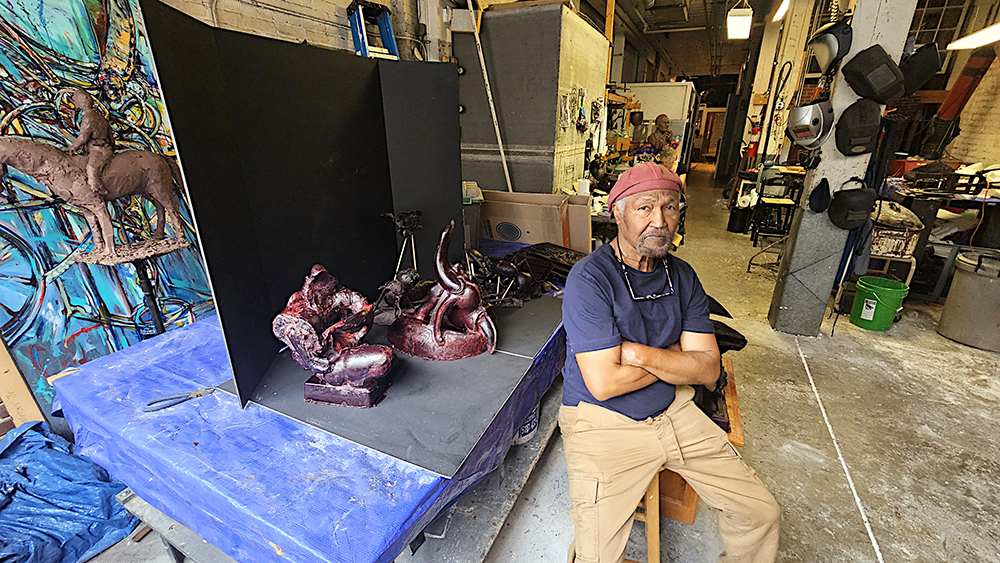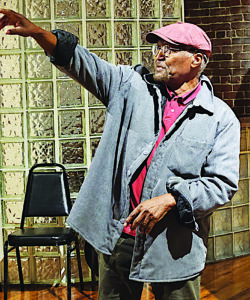
Local artist Preston Jackson takes a break at his creative space at the Contemporary Art Center.
BILL KNIGHT
There’s still time to enjoy Preston Jackson’s “Insights” exhibit at Peoria’s Contemporary Art Center, but don’t panic if you miss the latest display of the artist’s work.
He’s not slowing down.
Blocks away, he’s helped update his pivotal “Bronzeville to Harlem: An American Story” showing in a gallery at the Peoria Riverfront Museum, rededicated May 15. And he’s shaping new pieces in his workspace at the Contemporary Art Center.
“I am very busy,” says Jackson, 81. “Maybe I do have a slight fear of the message fading. (But) I know a lot of stuff; I’m smart about stuff — but then I make a bad decision. Then I realize it and rediscover something and I’m smart again. I evolve. It’s life.”
Life for Preston Jackson began in Decatur, where he found success through struggle.
“I was dyslexic, so I memorized patterns in words and numbers,” he says. “I drew some Korean War planes as a 7-year-old and got some attention and praise.”
He was 15 when he became more active, and 21 when he won some kind of statewide contest. “That’s when I thought, ‘Hey, I could make a living at this’,” he says.
Career path
After attending Millikin and graduating from Southern Illinois University, he earned a Master of Fine Arts from the University of Illinois and started a teaching career. He was an art professor at Western Illinois University for seven years, and then for decades taught at the Art Institute of Chicago, where he still serves as a professor emeritus of sculpture.
Jackson was honored with two Regional Emmys, and named as a Laureate of the Lincoln Academy of Illinois, and his work includes the traveling sculpture “Fresh from Julieanne’s Garden,” the historical landmark statue of Richard Pryor on Washington Street, and public art in Connecticut, Missouri, South Carolina, Tennessee and throughout Illinois.
Many of his subjects — all of which have personalities of their own, he says — “draw on my childhood memories.
“Everything I remember so well, the smells and sounds and gestures and stuff — much all gone now,” Jackson says. “I think about all that stuff in my makeup. So much of that comes out in my work. All things connect.”
Contemporary art
Scheduled through June 21 (See box), “Insights” features 18 sculptures and 11 paintings (what he calls “flat work”). The collection is both provocative and soothing, a sensory shower of impressions and instincts. “Eclectic, electric realism” doesn’t do it justice.
An observer trying to analyze or articulate Jackson’s work can feel like he’s doing a crossword puzzle wearing a blindfold.
The paintings are vivid, both brash and melancholy. The muted, yellow-green tones of “Songs of Old Men” are vibrant. “Guyanese Pride” shows a woman’s resolute demeanor projecting from a dark background. “Midnight Train to Memphis” is a kaleidoscopic clash of passengers’ discomfort, disappointment, hopes and confusion.
Likewise, his sculptures here are shapely and stimulating. “Condor Squadron” is a compelling depiction of a bird as a biplane. A second glance at “The Good Freighter” reveals a man shackled to the bow of a small boat
Man of the people

Preston Jackson gets creative at his studio in the Contemporary Art Center. His exhibit, “Insights,” there features 18 sculptures and 11 paintings. The display runs through June 21.
BILL KNIGHT
Holding court in an art reception or engaged in a casual conversation, Jackson talks in a rapid-fire staccato, then a slow, dreamy whisper, then back again to bold assertions, like Miles Davis scoring a Joseph Campbell lecture.
“I don’t explain it in an arty-farty way, a textbook way of explaining it,” he asserts.
Instead, he dismisses diagnoses and offers a judgment: “Anything is a reflection of the maker of it. Art will reflect who you are. There’s nothing you can do about it. It will always come out that way.”
With an easy, small smile, wary and wise, like a bright kid sizing up an adventure, Preston concedes that some of his work is rooted in history; some more immediate; much social commentary and all “people-oriented.”
“What comes out of my head could be dangerous,” he says, quietly chuckling. “Look at the history of this country; look at the condition where we are today, this time. It’s a racist environment. We’re destroying the planet. Sometimes that comes out in my work.
“When are we going to learn from history?” he’s asked, “— that a diverse society benefits us all?
“My imagination runs wild,” he continues. But “I don’t get over the top or lashing out or losing it. You need inner strength, ‘soft’ strength.
“Sometimes I project the negative so the positive can exist. It’s for the good.”
Jackson’s interests extend beyond visual art — from classic cars to music.
He’s occasionally thought of walking away from playing guitar; music takes a lot of time. But “muscle memory” can revive confidence.
“I’d been thinking of stepping back from playing — in a kind way,” he says. “But last night I played a gig and all that shit is still there. I was comfortable. Maybe a little cocky.”
As for cars, Jackson concedes he’s as much an observer as a participant. “At one time I had 16 cars; now I’m down to 2,” he says, sighing. “There’s just something about cars, like in the 1930s, when they seem like people or animals — water bugs, whatever.”
Personal perspectives and fond reminiscences drive him now, Preston says.
“All those thoughts and connections are still felt, all that life,” he says. “My work comes from those feelings. They’ve been there all along.”

Recent Comments